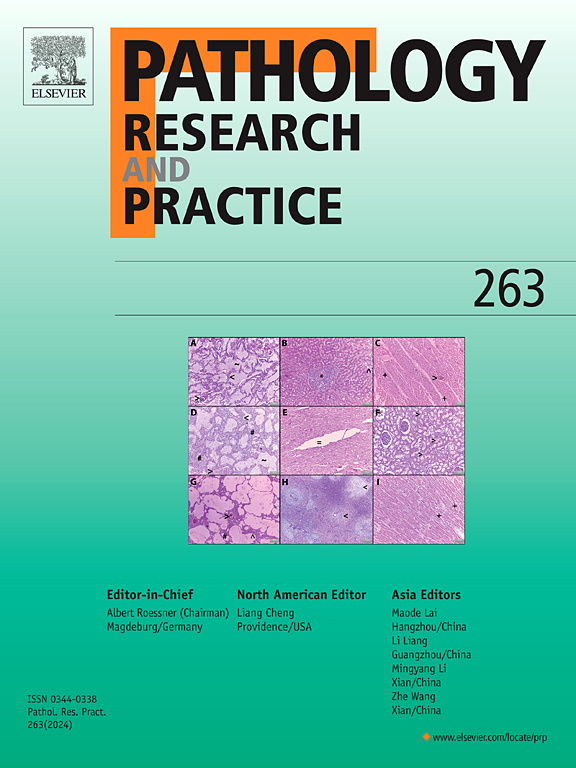rbbp6诱导的FOXP3失稳促进了葡萄糖代谢和hbv相关肝细胞癌的恶性进展
IF 3.2
4区 医学
Q2 PATHOLOGY
引用次数: 0
摘要
背景:与乙型肝炎病毒(HBV)感染相关的肝细胞癌(HCC)仍然是癌症相关死亡的主要原因,但驱动其进展的分子机制尚不完全清楚。叉头盒P3 (FOXP3)是一种参与免疫调节的转录因子,已成为多种癌症的潜在调节因子。然而,其在hbv相关HCC中的作用仍未被探索。方法采用定量反转录PCR (qRT-PCR)和western blotting检测FOXP3、视网膜母细胞瘤结合蛋白6 (RBBP6)和血管生成/转移相关标志物血管内皮生长因子(VEGF)、基质金属蛋白酶-9 (MMP-9)、转化生长因子β (TGF-β)。功能测定包括CCK-8、流式细胞术、菌落形成、Transwell和试管形成测定,以评估增殖、凋亡、迁移、侵袭和血管生成。通过比色法分析葡萄糖代谢。采用谷胱甘肽s -转移酶下拉、共免疫沉淀、泛素化、染色质免疫沉淀(ChIP)和双荧光素酶报告基因检测检测FOXP3、RBBP6和调控因子X5 (RFX5)之间的蛋白相互作用。采用异种移植小鼠模型验证hbv相关HCC细胞的体内致瘤性。结果foxp3在hbv阳性HCC组织和细胞中表达下调,而RBBP6表达上调。此外,FOXP3过表达抑制HepG2.2.15细胞的增殖、迁移、侵袭、葡萄糖摄取、乳酸生成和血管生成,同时促进细胞凋亡。此外,结果表明RBBP6通过泛素化使FOXP3失稳,RBBP6敲低通过恢复FOXP3功能抑制肿瘤的发生和葡萄糖代谢。在hbv阳性HCC细胞中,RFX5转录激活RBBP6。此外,该研究还发现,RBBP6敲低抑制体内肿瘤的形成,同时在hbv阳性HCC细胞产生的移植肿瘤中FOXP3的表达增加。结论rbbp6泛素化并破坏FOXP3的稳定性可促进hbv相关HCC的糖酵解代谢和恶性进展。靶向RBBP6-FOXP3轴可能为hbv驱动的HCC提供一种新的治疗策略。本文章由计算机程序翻译,如有差异,请以英文原文为准。
RBBP6-induced destabilization of FOXP3 promotes glucose metabolism and malignant progression of HBV-related hepatocellular carcinoma
Background
Hepatocellular carcinoma (HCC) associated with hepatitis B virus (HBV) infection remains a leading cause of cancer-related mortality, yet the molecular mechanisms driving its progression are incompletely understood. Forkhead box P3 (FOXP3), a transcription factor involved in immune regulation, has emerged as a potential regulator in multiple cancers. However, its role in HBV-related HCC remains unexplored.
Methods
Quantitative reverse transcription PCR (qRT-PCR) and western blotting assays were utilized to assess FOXP3, retinoblastoma-binding protein 6 (RBBP6), and angiogenesis/metastasis-related markers including vascular endothelial growth factor (VEGF), matrix metalloproteinase-9 (MMP-9), transforming growth factor β (TGF-β). Functional assays included CCK-8, flow cytometry, colony formation, Transwell, and tube formation assays to evaluate proliferation, apoptosis, migration, invasion, and angiogenesis. Glucose metabolism was analyzed via colorimetric assays. Protein interactions among FOXP3, RBBP6 and regulatory factor X5 (RFX5) were examined using glutathione S-transferase pull-down, co-immunoprecipitation, ubiquitination, chromatin immunoprecipitation (ChIP), and dual-luciferase reporter assays. A xenograft mouse model was used to validate in vivo tumorigenicity of HBV-related HCC cells.
Results
FOXP3 expression was downregulated in HBV-positive HCC tissues and cells, contrasting with RBBP6 upregulation. In addition, FOXP3 overexpression suppressed HepG2.2.15 cell proliferation, migration, invasion, glucose uptake, lactate production, and angiogenesis while promoting apoptosis. Moreover, the result showed that RBBP6 destabilized FOXP3 via ubiquitination, and RBBP6 knockdown inhibited tumorigenicity and glucose metabolism by restoring FOXP3 function. RFX5 transcriptionally activated RBBP6 in HBV-positive HCC cells. Further, the study revealed that RBBP6 knockdown inhibited tumor formation in vivo, accompanied by the increased expression of FOXP3 in the transplanted neoplasms resulting from HBV-positive HCC cells.
Conclusion
RBBP6 ubiquitinated and destabilized FOXP3 to enhance glycolytic metabolism and malignant progression of HBV-related HCC. Targeting the RBBP6-FOXP3 axis may offer a novel therapeutic strategy for HBV-driven HCC.
求助全文
通过发布文献求助,成功后即可免费获取论文全文。
去求助
来源期刊
CiteScore
5.00
自引率
3.60%
发文量
405
审稿时长
24 days
期刊介绍:
Pathology, Research and Practice provides accessible coverage of the most recent developments across the entire field of pathology: Reviews focus on recent progress in pathology, while Comments look at interesting current problems and at hypotheses for future developments in pathology. Original Papers present novel findings on all aspects of general, anatomic and molecular pathology. Rapid Communications inform readers on preliminary findings that may be relevant for further studies and need to be communicated quickly. Teaching Cases look at new aspects or special diagnostic problems of diseases and at case reports relevant for the pathologist''s practice.

 求助内容:
求助内容: 应助结果提醒方式:
应助结果提醒方式:


